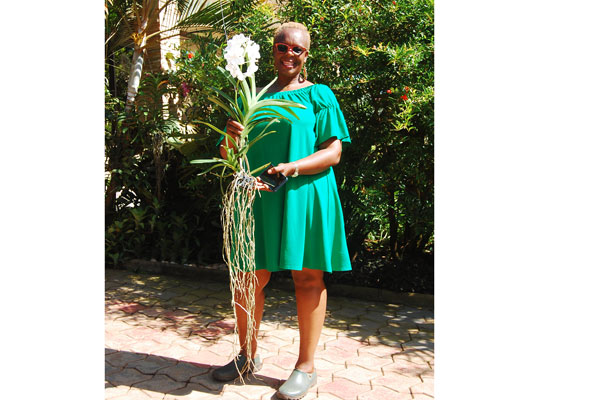Prime
Gardening: Air plants thrive without soil

A gardener unhooks orchid from her garden to pose for a photo. Photo/Tony Mushoborozi.
What you need to know:
- Air plants attach to tree bark or an old neglected concrete slab, a rock or wall only for support and not sustenance. They are not parasitic at all because they don’t get any nutrients from the host.
Air plants are a variety of epiphytes (plants that need no soil to grow). While they dont need soil to grow, they need a host platform to commence growing. They attach to tree bark or an old, neglected concrete slab, a rock or wall only for support and not sustenance. They are not parasitic at all because they don’t get any nutrients from the host. They receive their nutrition from the moisture and dirt in the air. plants are more seemingly what they sound like. They grow well in the air and no soil is required at all.
These fascinating plants are quite accommodative and can be grown in just any garden space. They add a tender and classy touch to any garden they find themselves.
Here is how best you can create an enabling environment for them to thrive favourably in your spaces.
Environments
Well, unlike other plants, air plants like orchids do not require soil to grow. This gives them a broad suggestion of how they can be displayed dreamily in your home space.
To start with, air plants serve a great look when displayed in groups of several varieties, says Judith Namazzi, a gardener.
“Air plants rely on a combination of air and water to grow, but aren’t as dependent on water as traditional plants. ” she tips.
You can also find glass or plastic globes that are made specifically for hanging them.
“These epiphytes tend to grow in the sheltered, shady canopy of trees even in the wild which is representative of their dependent nature on other plants.”
Conditions
Potting air plants proves to be a walk in the park as they require little or no containerising.
Given their ability to thrive while basically hanging off a glass globe or a tree branch, or a wire, they do not demand much thought to bottling priorities.
Even at that, the expert recommends a keen interest in regulating the amount of water and light plus the right temperatures that these plants require.
“Similarly to other plants, keep your air plants out of direct sunlight. They will do best if you can put them in a brightly lit spot out of the sun’s rays,” she shares.
These plants, she explains, receive the best sunlight during morning hours which is less intense and are best positioned at balconys or window seals.
Air plants thrive best in warm weather. Therefore you ought to protect your plants from anything colder than 45 degrees. Otherwise, they will die at those temperatures.

Maintenance
Air plants don’t have roots like other plants; they only have a few short ones which are meant to help hold it onto whatever surface they are using for suport.
According to Namazzi, air plants thrive best in humid placements and plentiful rainfall.
“To water them, place them in a sink or small jar with enough water to soak for about half an hour after which give a gentle shake to dislodge the liquid,” she explains.
You do not need to worry about too much water that affects the rooting of the plant simply because there is no soil involved.
However, she recommends gardeners to consider watering them about once a week noting that some varieties can go two weeks without being watered.
Namazzi suggests that one ought to keep a watchful eye on whether their plants need a drink. If tthese plants start wilting, that is a sign that the watering has not been adquate.
You will know that an air plant is getting what it needs when it sends up flowers.
Once the flower dries out, just snip it off and your air plant will keep on growing and eventually making more blooms.
During the wet seasons, you can sprinkle a bit of water molecules on to the plants to keep them fresh given that humidity rate tends to be lower at the time.
Price
A full grown orchid like the one on the right costs between shs150,000 to shs250,000 to buy. All it takes to have an orchid like this is you take it home and hang it on a tree branch on a wire line. It is one of the easiest plants to grow so long as you don’t hang it in direct sunlight, according to Chekwoti, a Kira based gardener.





